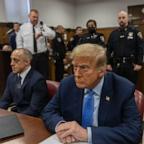Trade grades: Can Jahlil Okafor resurrect his career with Nets?
The deal
— --
Nets get:?Center Jahlil Okafor, guard Nik Stauskas, the Knicks' 2019 second-round pick
76ers get:?Forward Trevor Booker
Brooklyn Nets: B
Brooklyn always stood out as a logical Okafor destination.
The Nets have one of the league's weakest center rotations, with only rookie Jarrett Allen as a potential long-term option at the position. Timofey Mozgov, whose contract was part of the price of getting D'Angelo Russell, has seen action in just two games since Nov. 14. Tyler Zeller, signed for the veteran's minimum as a free agent over the summer, has started seven games at center.
Though he's played well offensively, Zeller shouldn't prevent Okafor from getting minutes in Brooklyn. So now the question is whether Okafor can make good on his second chance.
Doing so will require improvement on offense. Yes, you read that correctly. All the focus on Okafor's defensive shortcomings -- and they're significant ones -- has overshadowed the fact that so far during his NBA career he's rated worse at the offensive end of the floor, even after one accounts for the fact that centers are typically more valuable on defense than offense.
Take ESPN's real plus-minus. While Okafor ranked 67th among centers in defensive RPM (minus-1.3) last season, he was 69th -- dead last -- with a minus-4.4 offensive RPM. Last year, the 76ers scored 7.7 fewer points per 100 possessions with Okafor on the court, according to NBA.com/Stats.
While that can be explained by Okafor rarely sharing time with Joel Embiid, the Philadelphia offense was similarly worse with Okafor in 2015-16 ( minus-7.6 points per 100 possessions) despite the weaker offensive alternatives at center. That partially owed to lineups with Okafor playing alongside Nerlens Noel, but with just Noel on the court, the 76ers' offensive rating was 3.2 points better than with Okafor alone.
How can this be, given Okafor's reputation as a dominant offensive player? Well, for one thing, he hasn't been particularly efficient. Because Okafor hasn't been the same kind of high-percentage finisher he was as a college player (he shot 66.4 percent on 2-point attempts at Duke), and because he's a sub-70 percent foul shooter, his true shooting percentage has hovered right around league average during two NBA seasons.
Still, average-ish efficiency with above-average volume (Okafor's usage rate in his first two seasons was 27.3 percent of Philadelphia's plays as a rookie and 24.1 percent in year 2) should ordinarily translate into above-average value, so that's an incomplete explanation. The greater issue seems to be Okafor's limited playmaking for teammates. His 2.2 assists per 100 team plays last season were sixth lowest among players with usage rates greater than 22 percent.
It's possible for such a player to have value offensively but typically only as a high-efficiency scorer. Enes Kanter of the crosstown New York Knicks is the model the Nets should hope to emulate with Okafor. After scoring with mixed efficiency during three-plus years playing for the Utah Jazz, Kanter became a high-percentage scorer with the Oklahoma City Thunder and has maintained that since his trade to the Knicks.
Like Kanter after the trade to Oklahoma City, Okafor will enjoy the best floor spacing he's ever seen in Brooklyn. However, Okafor doesn't benefit from as many of the easy scores on putbacks that Kanter got throughout his career. And even playing with a stretch big didn't seem to help Okafor's efficiency much with the 76ers; his true shooting percentage improved to only .552 when Philadelphia's other centers and nonshooter Jerami Grant were off the court, via NBAwowy.com.
Because the Sixers declined the fourth-year option on Okafor's rookie contract, the Nets will be in a tough spot if they can turn him into a contributor. Okafor will be an unrestricted free agent next summer, and Brooklyn cannot offer him a starting salary of more than $6.3 million, the value of the declined option year.
Of course, the structure of this trade -- with the Nets getting a pick rather than giving one up -- suggests the Nets might be more interested in getting the second-round pick, which should probably be expected to fall near the middle of the round in 2019.
Besides Okafor, Brooklyn will also take a flier on Stauskas, another lottery pick who hasn't developed as expected. If Stauskas is going to make it anywhere in the league, it's probably Brooklyn, where coach Kenny Atkinson has empowered his players to take all the 3s they can handle. Stauskas made a career-high 36.8 percent of his 3s last season, though his poor 2-point shooting and defensive limitations meant Stauskas still rated worse than replacement level. Stauskas, who will be a restricted free agent, is also in the final season of his rookie contract.
Losing Booker will cost the Nets some depth at power forward, where he was the primary backup to Rondae Hollis-Jefferson. Brooklyn can slide Quincy Acy over now that he's unlikely to play as many minutes as center, while going small with DeMarre Carroll at the 4 is also a more likely option now.
Ultimately I doubt this deal will have much impact on the Nets' 2017-18 record -- important because it determines the first-round pick the Cleveland Cavaliers will get from them via the Boston Celtics.
Philadelphia 76ers: C
Given neither Okafor nor Stauskas seemed to fit into Philadelphia's long- or short-term plans -- they've played a combined 70 minutes all season -- from a value proposition, this is basically the Sixers trading a second-round pick for having Booker the remainder of the season. (He'll be a free agent at year end and won't affect the team's 2018 cap space.) And that seems OK.
Despite making the occasional 3-pointer now, Booker is more or less the same player he's always been -- a decent reserve who's overexposed in a larger role. He's a strong rebounder who blocks a few shots and scores with average efficiency. That doesn't fill a huge need for the 76ers, who have given their power forward minutes to Dario Saric and Ben Simmons, but Philadelphia didn't have another good option at the 4 if either of those players were to miss time. So this might be a slight boost to the Sixers' playoff hopes.
A side benefit here is that by trading two players for one (a move that required Brooklyn to waive backup guard Sean Kilpatrick), Philadelphia clears a roster spot. Because they still have their $4.3 million room midlevel exception available, the 76ers could be an attractive landing spot for buyout candidates. (That exception will prorate after Jan. 10, meaning the Sixers wouldn't have as much to offer after the trade deadline.)
Bobby Marks' analysis:
The addition of Booker does not help the 76ers' logjam of frontcourt players. But it gives Philadelphia a veteran insurance policy and a glue guy who is not afraid to get his hands dirty.
Booker, a free agent in July, creates a $9.1 million cap hit, and the Sixers will inherit his early Bird rights in free agency. Booker could fit the mold of Amir Johnson and J.J. Redick, 2017 free agents signed by Philly to one-year contracts at a high salaries to preserve cap space for the future.
Even with Booker having a career year, Nets GM Sean Marks did not have blinders on. Brooklyn, a team short of assets, acquires two former lottery picks in Okafor and Stauskas along with the Knicks' 2019 second-round pick. The move gives the Nets a five-month evaluation period for both players. Okafor will be a free agent, and Stauskas will become a restricted free agent if the Nets give him a qualifying offer in the offseason.
Not to be lost in the trade was the Nets' waiver of shooting guard Kilpatrick. After averaging a career-high 13 points last season, the shooting guard has seen limited minutes this season. Kilpatrick and his $1.5 million salary are eligible to be claimed by a team with cap space, trade exception or disabled exception. While the Nets currently have $3.7 million in cap room, that would increase to $5.2 million if Kilpatrick is claimed.




